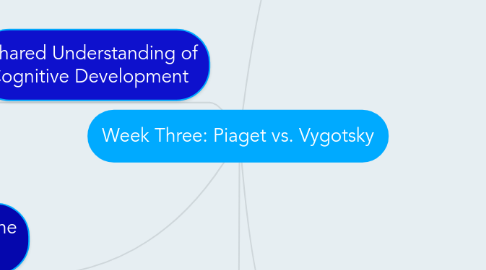
1. Comparison of Piaget & Vygotsky
1.1. Similarities
1.1.1. Both understand childhood to be an important time in developmental growth, which can be boosted or hindered by the child's environment.
1.1.2. Both believed that children should be pushed intellectually, which would lead to growth. (Olmrod, pg. 44)
1.1.3. Not surprisingly, both believed that as children age they acquire the ability to handle increasingly complex ideas.
1.2. Differences
1.2.1. While Piaget sees children as naturally inquisitive and eager to learn, Vygotsky believes that learning must be initiated by adults.
1.2.2. Though both theorists believed that culture had some impact on childhood development, Vygotsky believed culture played a much larger role than Piaget did. Vygotsky believed that culture determined the way in which children thought and the skills they acquired. (Olmrod, pg. 44)
2. Shared Understanding of Cognitive Development
2.1. We all agree that cognitive development is a combination of both Piaget and Vygotsky's theories. We have seen through teaching and learning experiences that children have a natural thirst for knowledge but often need adults to help guide the learning process. We strongly agree with Vygotsky that culture plays a role in cognitive development. As teachers, we agree that we need to cater or teaching style and lesson plans to the ages and developmental stages that our students are in.
3. Cognitive Development in the Modern Classroom
3.1. Children learn better hands-on learning and social interaction.
3.1.1. Example: Encouraging students to work in small groups, therefore fostering learning between the children.
3.2. Having a knowledgeable adult, in this case a teacher, to help guide the learning process but NOT dominate it.
3.2.1. Example: Having a teacher guide a student's thinking as they work through a mathematical problem. (Encouraging productive struggle)
3.3. Culture plays a role in how children learn, teachers need to be mindful of that.
3.3.1. Example: Teachers understanding the differing worldviews surrounding education. (i.e. Europeans think of education as an individualistic activity whereas other cultures view it as a communal activity)
4. Piaget's Main Ideas
4.1. Children are naturally active and motivated learners. (Olmrod, pg. 28)
4.1.1. Children are eager to learn about the world around them in order to construct a better understanding of what they are seeing.
4.1.1.1. Constructivism: Theoretical perspective proposing that learners actively construct (rather than passively absorb) knowledge from their experiences. (Olmrod, pg. 27)
4.1.2. This concept is important to keep in mind, especially when teaching elementary age children because it suggests that children are naturally curious and receptive to new knowledge.
4.1.2.1. As a teacher it is important to foster your students' sense of curiosity and create lesson plans that take advantage of their natural desire to learn.
4.2. Cognitive development occurs in four distinct and separate stages. (Olmrod, pg. 29)
4.2.1. Sensorimotor: Begins at birth, children can only focus on that which is right in front of them.
4.2.2. Preoperational: Begins around the age of two, children can think about things that are not physically in front of them but still cannot logically reason like adults.
4.2.3. Concrete Operations: Beginning around age six, this stage sees the beginning of adult-like reasoning. But, reasoning is limited to real-life situations and problems.
4.2.4. Formal Operations: Begins around the age of eleven, children can finally think logically about abstract ideas. This lays the foundation for future mathematical and scientific thinking.
4.2.5. Like the idea above, this idea is important for teachers to keep in mind because these stages indicate what lessons are suitable for children at every life stage.
4.2.5.1. Teaching a child about something that is above their developmental stage might lead to frustration and confusion.
5. Vygotsky's Main Ideas
5.1. Cognitive development must be fostered by adults. (Olmrod, pg. 36)
5.1.1. Through both informal conversations and formal schooling, adults convey to children the ways in which their culture interprets and responds to the world. (Olmrod, pg. 37) (Zone of Proximal Development)
5.1.2. Adults must have the understanding of the subject to teach the information. In the classroom, Adults must bridge the gap between old and new information.
5.1.3. Adults need to be mindful of the children's need to play and and slowly encourage their growth.
5.2. Every culture passes along physical and cognitive tools that make daily living more productive and developed. (Olmrod, pg. 37)
5.3. Thought and language become increasingly more interdependent as the child develops (Olmrod, pg 37).
5.3.1. In the classroom, when students are lead in a discussions, the opportunity to expand cognitive thinking is increased.
